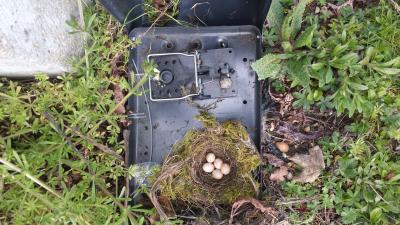Those of you who follow us on social media will know that over the last few weeks we have had quite a few encounters with birds.
In the first case, I was called to a disused garage by a couple of concerned neighbours - they were complaining about a damp problem on a connecting internal wall. When I entered the property I was met by around 30 pigeons. They had been using a broken window to gain entry to the building and had found it the ideal place to breed and, of course, this results in plenty of unhygienic mess.
In the second instance, our technicians were called to a large development of flats in Feltham, Middlesex. The manager of the site had called us in because one of his tenants reported hearing strange noises coming from the ceiling of one of the flats’ bathrooms. During our investigation we found broken vent covers and pipes, and identified the culprits as parakeets. They had used their extremely strong beaks to break through the vent covers and had then chomped their way through the pipes. These secluded places had made perfect nesting sites for the parakeets. Once we had established that the birds had finished nesting, we used a large cherry-picker to gain safe access to the vents and replaced the broken plastic covers with metal covers. It really is amazing just what a parakeet’s beak can destroy.
At this time of year, we are often called to help people deal with bird problems. The birds are looking for nesting areas and if they find a way into your attic, or any hidden away area, they can make not only a terrible mess, but also can cause structural damage to roof joists. Their waste can also represent a hazard to health as it can contain nasty diseases. A study in the US has concluded that birds can carry over 60 diseases, including: Cryptococcosis, Histoplasmosis, Salmonellosis, E.coli and Meningitis. Ironically, in mediaeval times a proposed cure for Meningitis was to split a pigeon in half and place it on the patient’s head. Finally, birds can also introduce secondary pests, such as textile moths and beetles, to your property.
At Cleankill Pest Control we have a number of techniques at our disposal to stop birds entering your property. In some cases, this is as simple as a technician surveying your property to check it is bird-proof and that may result in filling gaps where birds can enter your attic. In some cases, to deter birds from perching and nesting on a property, we can use a non-toxic gel that is invisible to human eyes, but appears like flames to a pigeon’s eyes. In very specialised cases, we have even been known to bring in a Harris Hawk called George, in order to scare away problem birds.
Finally, the most common form of bird-proofing, however, is netting. In the right situation, this can be used to cover a large area but you do need to get it checked annually to ensure its effectiveness. In our third recent case, we had installed bird-netting for a client last year and it had been wholly effective. However, in December, scaffolders had ripped the netting and so, during the last three months, pigeons had used this, and an open door, to gain access to a disused part of the property. When I visited in April, I found over 40 pigeons in the room and you can image the mess they had made. We had to remove the birds, mend the netting and clean up the fouling.
It just goes to show how clever birds are at exploiting any weakness in a property’s defences. This is why we always recommend getting your nets checked annually, before the nesting season.
Finally, however, we also had a nice story concerning our avian friends’ ability to exploit a situation. At the end of April, one of our technicians was undertaking his monthly check of the pest traps at a site in Colnbrook. The technician realised the trap had been sprung and was expecting to find a trapped rodent. Instead, he opened the box to reveal a neat nest of Robin’s eggs - he had seen the mother near the box when he was checking the site. The nesting materials had sprung the trap inside, but luckily the bird hadn’t been injured. The technician removed the trap, closed the box and has made a note warning people not to open the box until after the breeding season had ended. For more information on how to deal with pigeons, parakeets, gulls, and other bird pests, you can find more information on our website.
